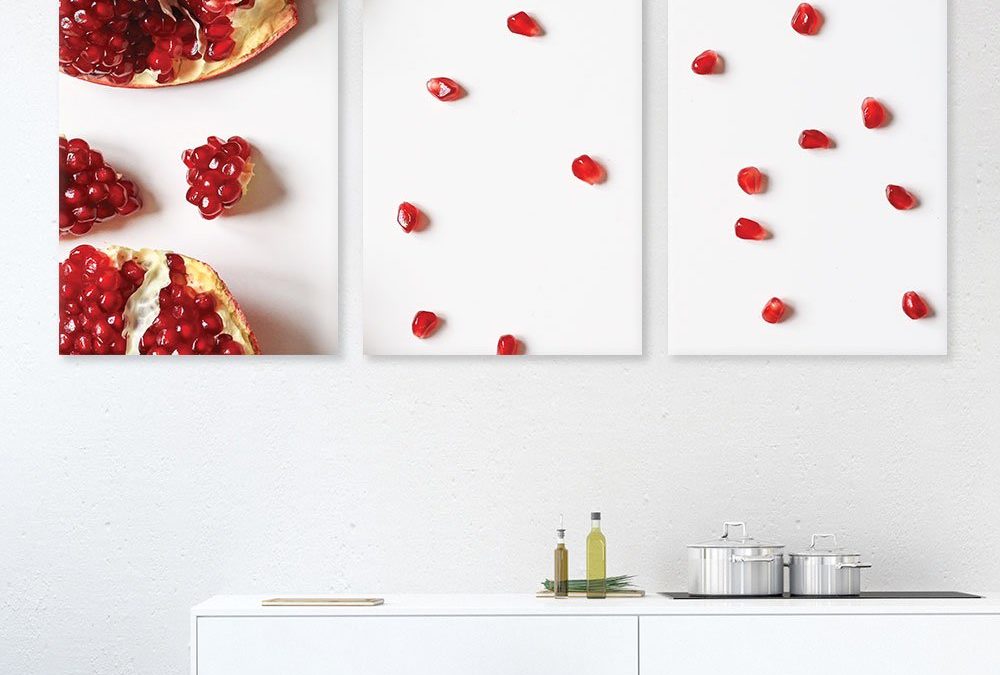Fruits are one of the most interesting types of foods. Why are they interesting? We’d say it’s because of the variety that they offer. For example, people know about common fruits like bananas, apples, strawberries and oranges. That said, how many know about more exotic fruits? Dragon fruit, rambutan, lychee? One of favorite types of exotic fruits is the pomegranate! An ancient fruit that’s commonly the subject of symbolism and religious importance in media, the pomegranate is native to Iran. First domesticated by Persians, pomegranate farming quickly spread throughout Israel and India, and then to North Africa and the Mediterranean. During the 16th century, the Spanish brought the pomegranate to the Americas, and by the 1700s pomegranate trees were being grown in what is now the southern United States. Interested in learning more? Read below for more pomegranate fruit wall art facts!
Red Like a Ruby

- As previously stated, pomegranates are ancient fruits with quite a bit of history behind them. Are you interested in knowing an old myth? The myth of Persephone was that she was kidnapped by Hades, the god of the underworld. Hades invited her to the underworld and tricked her into eat pomegranate seeds. Persephone did not know that if someone consumes something in the underworld, that person is forced to remain there. The time she spends there is the mythological explanation for why we have winter.
- Are you interested in where the word pomegranate comes from? It means “seedy apple” in Latin, with the root words being “pomum” and “granatus,” meaning apple and seedy respectively. The same Latin root words are responsible for naming the Spanish city Grenada and grenadine, which is a sweet pomegranate-based syrup that is usually mixed into cocktails. Additionally, the word “grenade” comes from the French word for pomegranate, probably because the earliest grenades closely resembled the fruit.
- Pomegranates are about the size of a grapefruit, and have extremely thick skin. Cultivars located in the United States usually contain pomegranates that have its characteristic dark red skin, but there are also varieties throughout the world that have orange, yellow and pink colored rinds. The interior of pomegranate is filled with arils, which are the juicy coatings that cover pomegranate seeds. Wondering what to look for when buying pomegranates at the market? Simply pick one up and if it feels heavy. it’s ripe. If it feels light, you shouldn’t buy it. Read below for more pomegranate fruit wall art facts!
Ripe and Red

- Are you a locavore? By that, we’re asking if you only eat food that is produced locally. If you are, then pomegranates may not be the fruit for you! That is, unless you happen to live in California! Nearly all of the pomegranates that are in markets in the United States are shipped straight from California. Pomegranates in California are generally at their freshest in September and October. Pomegranate season ranges from those months through January.
- Pomegranates are seen as intimidating by many because of their appearance and texture. It isn’t immediately obvious how one is to eat a pomegranate from just looking at one. There are essentially to ways to get inside of a pomegranate. The first? Simply cut your pomegranate in half. Next, hold one half of your fruit cut side down, then whack the back of the rind with a large spoon until the fruit comes out. The second? Fill a bowl with water. Cut the pomegranate into quarters. Next, submerge your pomegranate and pick out the seeds with your fingers!
- Wondering what the most famous pomegranate dishes are? In Persian culture, it would be fesenjan. Fesenjan is dark meat chicken and duck topped with a thick, molasses-like walnut and pomegranate sauce. Another is Mexico’s chile en nogada. This dish is composed o fresh green chilis that are covered in a creamy white walnut sauce and then topped with pomegranate seeds. These colors represent those that are on the Mexican flag! Did you enjoy these pomegranate fruit wall art facts?
Conclusion
Want another fact? Pomegranates are highly nutritious and useful in many applications. In fact, ancient cultures used the seeds, bark and flowers of pomegranate trees as a cure for intestinal worms and inflammation. Pomegranates are a good source of vitamin C and K, and they’re a good source of folate, potassium, copper and iron. So, what are you going to do now? Go to the market and buy your own pomegranate? We hope you do! Thanks for reading these pomegranate fruit wall art facts!

